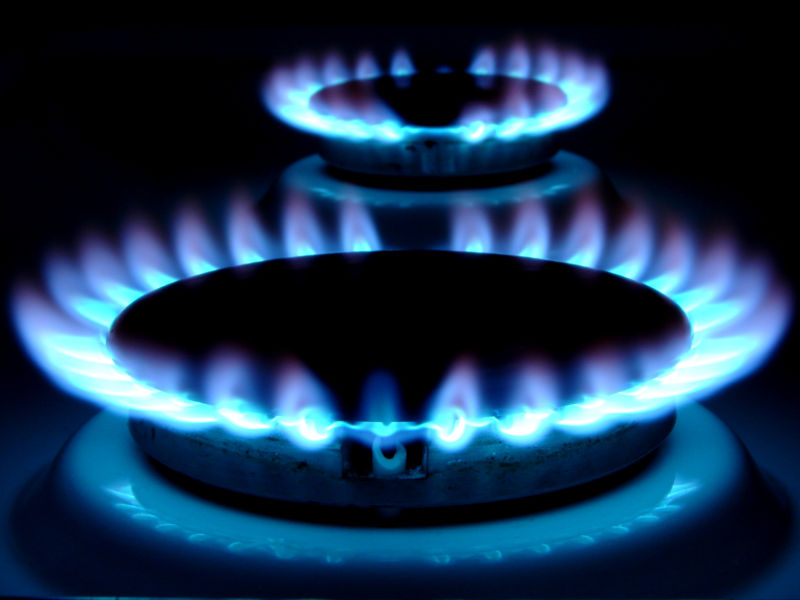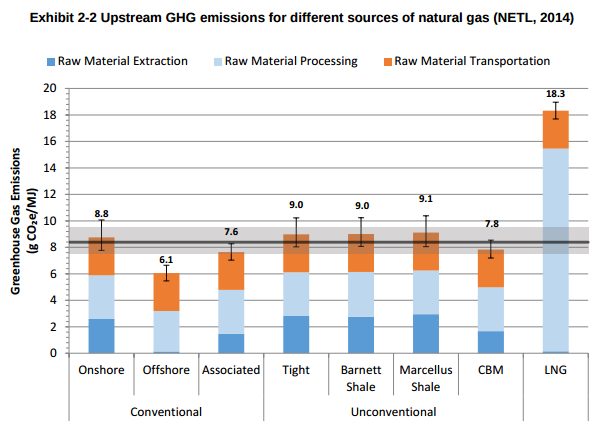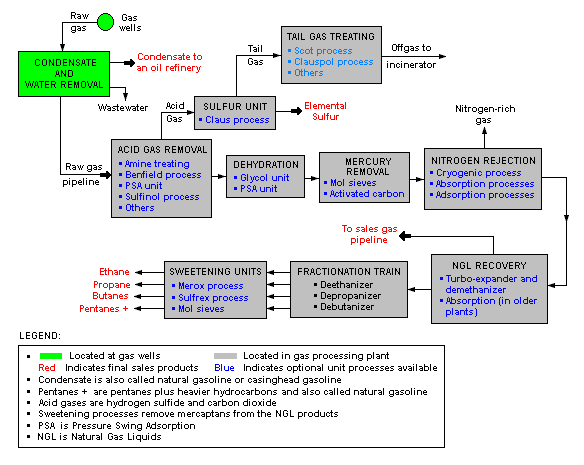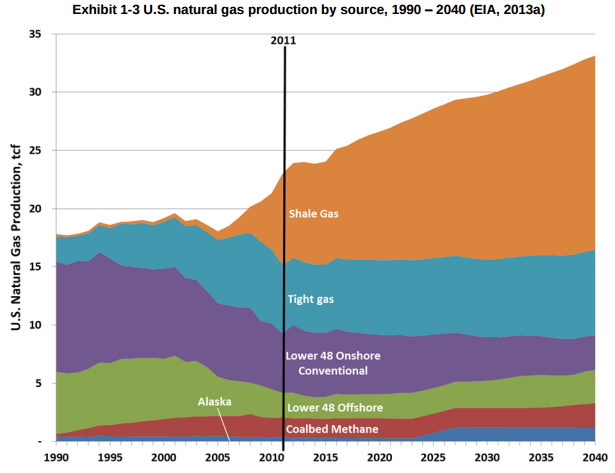Last Update: July 18, 2015

Supposedly natural gas is cleaner than gasoline, making it the fuel of choice to clean up the environment. But it's a fossil fuel, meaning it still contributes to global warming. A few years ago natural gas supplies were getting tight, but thanks to fracking its production is on an upswing. At the point where natural gas is consumed it is cleaner than coal - it's so clean that we routinely burn open natural gas flames in kitchens, and water heaters, and heating systems without worrying about the impact. However, natural gas production isn't terribly clean - methane leaks for example are a potent greenhouse gas.

Like crude oil, natural gas is the result of decomposition of plants and animals sequestered millions of years ago. [UCS1] Primarily it's formed in former ocean areas, from plants and animals that fell to the sea floor and then was covered by mud and silt. Ensconced within geologic strata the biological material underwent transformations which converted it into highly potent fossil fuels. Often natural gas is formed alongside crude oil or coal, where it's called "associated gas", and they can be mined at the same time.
Such natural gas is "conventional natural gas" meaning it's the easy-to-get stuff only requiring a pipe stuck in the ground. As we see below, conventional gas fields have begun to run out and the industry is having to adopt other more energy and resource intensive methods. Those fields, either shale deposits or "tight sand gas" have what's called "unconventional natural gas". [UCS2]
The powers-that-be see natural gas as being preferable to Coal, because official pronouncements say natural gas is cleaner than coal. Natural gas electricity plants are replacing coal plants, natural gas is being used as a fuel for big trucks and all kinds of other uses. Governments are encouraging the switch to natural gas in the context of fighting climate change. But not all is rosy about natural gas. Increasingly the natural gas supply is a byproduct of fracking (hydraulic fracturing), which has significant environmental negatives. Systems to process and transport natural gas are leaking prodigious amounts of methane, a potent greenhouse gas, into the atmosphere. And, of course, natural gas is a fossil fuel so its use contributes to climate change even if it theoretically contributes less than Coal.
Greenhouse gas impact
Natural gas is largely methane, an extremely potent greenhouse gas. As we see below, significant amounts of natural gas leak into the atmosphere.
When natural gas is burned it's converted to CO2 (and some other chemicals) as we see below.
While the climate and environmental impact of natural gas is probably less than coal - it's still significant.
While natural gas burns cleaner at the power plant, that's not the entire story. [UCS3] [HUFF1] There are pollution increases at natural gas wells, significant impacts on wildlife, groundwater pollution, surface water pollution, and earthquakes are all known byproducts of natural gas extraction.
According to a study by the American Progress Institute, U.S. natural use must "peak" by 2030 in order to meet climate change goals.
The paper notes: "Natural-gas plants, for example, emit 55 percent less carbon dioxide, 80 percent less nitrogen oxides, and 100 percent less sulfur oxides, mercury, other heavy metals, and particulate matter than coal plants." Hence, by offsetting coal consumption, natural gas consumption is positive. But, the paper goes on to note the various negative side effects we've documented on this page. Most important is that even if we reduce carbon emissions from gasoline, diesel and coal, but keep on with natural gas, total emissions will not reduce enough to meet the 2030 target.
Natural gas production
Natural gas isn't produced just by sticking a pipe into the ground and piping the "natural" gas directly to our homes. [Wikipedia1] [DOT1] [UCS4] Raw natural gas has impurities that must be removed, and of course since it is odorless a chemical is added to natural gas to give it that "natural gas smell".
Natural gas is typically produced from three kinds of wells:
- Crude oil wells: Crude oil often has natural gas dissolved in the oil. When the oil is brought to the surface that natural gas escapes and is called "associated gas." Often the natural gas is allowed to escape or is simply burned on site (flared) rather than collected and sold on the market.
- Gas wells: Produce only raw natural gas.
- Condensate wells: Produces raw natural gas along with other light hydrocarbons.
Once produced at the well head, raw natural gas is piped to a collection point. Any water in the gas is removed there, and discarded as wastewater. It's then piped to a centralized processing plant to undergo processes described below.
Methane leaks
Natural gas is essentially methane, and methane is a far more potent greenhouse gas than CO2. Any methane making it into the atmosphere therefore causes more climate change damage than does CO2.
Unfortunately it's difficult to detect methane, to quantify leakage from natural gas operations, and to separate the source of methane that does get measured between natural gas leakage and cow farts or naturally occurring methane. Some studies [NATURE1] suggest 4% of the methane produced at wells near Denver escapes into the atmosphere, and that 9% leakage has been measured in a field study in the Uinta Basin of Utah. [ClimateProgress1] Other studies [NYTimes1] suggest methane levels in the atmosphere are 50% higher than the EPA previously estimated, and the culprit may be methane leakage from natural gas production and distribution systems. The problem is leaky valves, storage tanks, pipelines, etc.
The methane leakage situation is so bad that one researcher expressed surprise that an advanced country like the U.S. would allow so much leakage. [ClimateScience1] [ClimateCentral1] Pennsylvania alone is thought to have a million abandoned natural gas wells leaking methane, based on research where in a sampling of abandoned wells every single one was found to be leaking methane. [ThinkProgress1]
On the other hand, the methane leakage may be improving. [IEEE1], The EPA cut its estimate of methane leakage in the greenhouse gas inventory due to "green completion". That's a process where natural gas well equipment is sealed against leakage. Also, some climate scientists point out the total amount of leaked methane is tiny compared to the CO2 emissions, and in any case methane degrades after 20 years or so while CO2's impacts are permanent.
Coal bed methane
This is a form of natural gas extracted from coal mines. [Wikipedia2] [USGS1] [EPA1] The methane is embedded in cracks and pores inside the coal, and because it's underground everything is at high pressure. As for natural gas embedded in crude oil, natural gas can be embedded in coal. The history of coal mining is full of accidents due to methane build-up that either suffocates miners, or causes explosions which kill miners.
It's been typical to simply vent methane from coal beds before mining the coal, as a safety measure.
The methane is extracted by drilling into the coal bed and pumping out water. That lowers pressure in the coal bed, allowing the natural gas to escape from the coal.
The water is usually a salt water brine, that's unsuitable to use on the surface and is therefore re-injected underground.
According to the U.S. EPA [EPA2] [EPA3] the methane which escapes from coal mining operations accounts for 10% of all man-made methane emissions in the U.S. Since methane is a very potent greenhouse gas, it's desirable to minimize emissions. Hence, extracting coal bed methane prior to coal mining operations is seen as beneficial.
Abandoned coal mines can still produce plenty of methane even though there's no mining operations. In the U.S. the EPA has identified over 400 "gassy" coal mines that might be prospects for coal bed methane projects.
Enhanced coal bed methane recovery
This is similar to enhanced oil recovery. Carbon dioxide is pumped into the coal bed where it then resides in the coal, displacing the methane. [Wikipedia3] Hence, this technique is one of the methods to implement carbon sequestration.
Landfill Gas & other natural methane sources - the non-fossil variant of natural gas
Most of this page focuses on fossil natural gas because that's the predominant source. As a fossil fuel, its consumption adds greenhouse gases to the atmosphere which is a bad thing. But that's not the only form of natural gas, since methane is a natural byproduct of biological decomposition. If we could find a way to capture cow farts we might have a large endless source of natural gas.
While that would be impractical, other sources of natural methane are available.
Because natural methane isn't a fossil fuel, its consumption does not add new carbon to the atmosphere and is therefore doesn't have the same greenhouse gas impact as burning fossil natural gas. [ANL1] [EPA4]
Landfill gas [Wikipedia4] [EPA5] [EPA6] [CalEnergy1] [NREL1] is a byproduct of microorganisms causing breakdown of biological material in landfills. The EPA believes there are over 6,000 landfills in the U.S. and that landfill methane is the largest source of anthropogenic methane emissions in the United States.
Landfill gas is fairly easy to collect - stick pipes into the landfill. It can be easily burned on-site in a microturbine. Some landfill operators convert the gas to a liquid form, which is used as a fuel for their garbage trucks.
Landfill gas is a form of Biogas. [Wikipedia5] Any biological material can undergo breakdown, and when done in the absence of oxygen Biogas (Methane) is formed. Once it's in that form, the methane can be processed in the same way natural gas is processed, then consumed in the same way, because it's essentially the same stuff.
Some sources of biogas are agricultural waste, manure, municipal waste, and sewage. That smell can be the smell of dollars, if channeled correctly.
Natural gas distribution

Natural gas is primarily transported via pipeline. [Wikipedia6] [EIA1] Natural gas is lightly compressed into "natural gas liquids" making it easier to pump through the pipes.
As you see in the picture above, the process from well to consumer involves several steps, and sometimes several "physical transfers of custody".
Natural gas storage systems are used to maintain pipeline pressure. Some storage sites perform "peak shaving" functions - meaning that their stored natural gas is only released during periods of peak demand. The storage facility operator earns revenue by shaving off peak demand.
LNG exports - the U.S. as a net natural gas exporter
Normally natural gas is distributed by pipeline, but of course pipelines aren't a feasible way to cross the Atlantic or Pacific Oceans. The method developed by the industry is tanker ships carrying liquefied natural gas (LNG).
The U.S. Government see's LNG exports as a way to help countries with dirty electricity systems to switch to a clean fuel. It's also seen as a tool for global power games - such as eroding
the power Russia has over Europe as the predominant natural gas supplier to Europe. However, due to natural gas leakage, it's thought LNG will never ever in a million years be a clean anything. [ThinkProgress2] While the natural gas extraction and processing system leaks natural gas (a.k.a. methane) anyway, LNG plants and LNG distribution have another form of methane leakage - "boil off". During transport, some LNG is purposely leaked to provide evaporative cooling to keep the rest of the LNG cool.
Greenhouse gas emissions in transporting raw natural gas before processing

This chart claims that GHG emissions from unconventional natural gas sources (like fracking) are not significantly different from conventional sources. The high GHG emissions from LNG transport is due to how much natural gas is consumed to run the compression & chilling machines used in compressing the natural gas.


These charts demonstrate that it's methane leakage that's the primary environmental concern for natural gas operations. Methane is a highly potent greenhouse gas, and all efforts must be made to limit methane emissions.
Compressors are a major contributor to GHG emissions in both conventional and unconventional gas production. As noted earlier, natural gas is compressed before being put into the pipeline. Gas isn't compressed for free, because energy must be used to run the compressors.
Natural gas processing
Contaminants in raw natural gas include all the various hydrocarbons (ethane, pentane, butane, propane, etc) that are normal constituents of crude oil, carbon dioxide, hydrogen sulfide, nitrogen, helium, water. It can even be contaminated with naturally occurring radioactive material (NORM) like Radon.

TODO FIX URL
This is a generalized process diagram, and of course the actual processing steps depends on the contaminants at a given site. The point here is that while natural gas processing is simpler than
crude oil processing, it's still a non-trivial process.
There's also several byproducts that can be sold into the market.
Most of the processing is done at a centralized processing plant, and not at the well-head. The water, however, is removed during the transportation to that plant and is then disposed as wastewater.
Odorizing
Since natural gas is odorless and colorless any leaks are non-trivial to detect. An Odorizer is a gizmo which adds an "odorant" to a gas. [Wikipedia7] The orodants (smelly chemicals) used in natural gas include
- tert-Butylthiol is the main ingredient in many gas odorant blends
- Tetrahydrothiophene or THT, is used as an odorant for natural gas, usually in mixtures containing tert-butylthiol
- Ethanethiol, commonly known as ethyl mercaptan is used in LPG
Liquefied Natural Gas (LNG) and Compressed Natural Gas (CNG)
LNG is natural gas converted to liquid form for easier transportation. [Wikipedia8] In a liquid state it takes up 1/600th the volume of gaseous natural gas, making it feasible to transport natural gas overseas.
Parts of the natural gas are removed to simplify the process of condensing it to atmospheric pressure, and then the gas is cooled to -162 degrees C (-260 F).
Compressed Natural Gas (CNG) [Wikipedia9] is simply natural gas compressed to about 3,000 psi in a high pressure tank.
CNG is widely used by consumers as a cooking fuel, vehicle fuel, etc. LNG is only used for transport, and then only in vehicles capable of handling the cryogenic temperatures required. Some research is underway to use LNG in large vehicles - trains, trucks.
Natural gas consumption

Typically natural gas is burned, but can be used as feedstock to various industrial or chemical processes. [UCS5]
When natural gas is burned the air emissions include nitrogen oxides and carbon dioxides. The U.S. EPA claims the amount is less than when coal or oil is burned. [EPA7] Specifically, 1135 lbs/MWh of carbon dioxide for natural gas is half what a coal plant produces, 0.1 lbs/MWh of sulfur dioxide for natural gas is 1% what a coal plant produces, and 1.7 lbs/MWh of nitrogen oxides for natural gas is 1/3rd what a coal plant produces. There are additional emissions like carbon monoxide and nitrogen oxide. [Wikipedia10]
Methane, a primary component of natural gas, is emitted when there's incomplete burning, and from leakage (as mentioned earlier).
Because natural gas is a fossil fuel - it's the result of natural carbon sequestration from millions of years ago - its consumption adds more carbon to the atmosphere. Hence, it is a greenhouse gas and worsens climate change.
Facilities like natural gas fired power plants will take in water for cooling, which then may result in fish kills in rivers or streams. The EPA says there's no contaminants in discharged water, but the water will be hotter than the surrounding water and could affect life.
Most importantly there is no solid waste produced by burning natural gas.
Natural gas supply

Until the Fracking boom US natural gas supply was shrinking rapidly. In this chart this is represented by the dips of output covered by the purple and green wedges - both shrank rapidly beginning in the mid 1990's.
The U.S. would be in a bad situation energy-wise if the fracking boom had not occurred, because of how much domestic natural gas from normal sources supply shrank. The chart shows that natural gas supply went up is due to the growth of shale gas - hence fracking. It's clear from this chart the Energy Information Administration expects natural gas production from fracking to keep expanding at a huge pace.

This chart makes the EIA's expected natural gas bonanza seem like a pipe dream. That's because scientists have observed that production at these wells peaks almost immediately, and then rapidly falls off.
To understand the significance we have to return to peak oil theory. Oil company geologists noticed in the 1950's a pattern where once half the oil in a given field is extracted it starts to be harder and harder to extract more oil, and therefore the production rate declined. They took it a step further, summing the production of all fields on the planet to predict a bell curve to worldwide oil production. Other than the gas & oil production boom thanks to fracking, the peak of oil production occurred in 2005-6 just as the theory predicted.
In other words - consider natural gas production from all shale fields summed together. If every field behaves like this, within two months natural gas production falls off rapidly, won't frack'd natural gas production peak rapidly?
Indeed this is the point of a pair of books from the Post Carbon Institute.
Drilling Deeper looks at in-depth data of the critical shale fields in the U.S. gas & oil boom. It finds that both crude oil and natural gas production from those fields will peak by 2020. Snake Oil discusses the false promise of the oil & gas boom.
Suggesting the Energy Information Administration is flat out lying with that chart shown above.
Fracking for Natural gas - Unconventional natural gas
Unconventional Oil or Natural Gas is a loosely defined term generally referring to oil or natural gas from sources other than the typical traditional ones. [DOE1] For natural gas some examples are:
- Shale gas - requiring fracking
- Tight gas - requiring enhanced techniques like steam injection
- Coalbed methane
Quite a bit of information about fracking and other enhanced techniques were covered when we discussed crude oil extraction. Some salient points are:
- Fracking injects water, toxic chemicals and sand deep underground with the purpose of fracturing rock formations.
- Fractured rock formations release their fossil fuel - gas or crude oil - that's then extracted from the well
- The water injected underground is removed from the hydrological cycle, meaning the global water crisis is made worse
- Some water returns to the surface - produced water - but it's usually so full of toxicity as to make it unusable, and has to be disposed somewhere such as injecting it underground
- Injecting the produced water underground has been determined to have caused earthquakes near fracking facilities. Frequent earthquakes started occurring when fracking commenced in areas of Oklahoma, Texas and Kansas that aren't prone to earthquakes.
- Both toxic frack chemicals and natural gas are thought to be getting into the water table.



